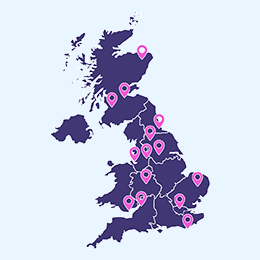- Licenced Business Rescue Experts
- Helping Directors in Debt
- Same Day Advice
For free expert advice, send us a message and we’ll be in touch

A Simple Guide to PVA’s (Partnership Voluntary Arrangements)
A partnership voluntary arrangement is a formal insolvency process that can help insolvent businesses that are still viable, to manage their debts and repay loans over a fixed period of time. An Insolvency Practitioner can help to decide whether a PVA is the best option for you and your business and guide you through the process.
Contacting experienced and professional insolvency experts such as ourselves will help you to ensure that your business has the best level of support and guidance needed when dealing with financial issues.
What is a PVA?
A Partnership Voluntary Arrangement (PVA) is a formal agreement whereby partnerships repay a proportion of business debts to unsecured creditors over an agreed length of time.
All partners must be prepared to work with the PVA and the business itself must be deemed viable and able to return to being solvent in the near future. It is especially useful if the business has sizable assets that are able to be sold to raise capital in the short term.
The PVA proposal is bespoke in nature and each PVA can therefore contain any offer to creditors that is agreed as being appropriate. Ultimately, the PVA encourages viable partnerships into profitability. A PVA is similar to the limited company version, a Company Voluntary Arrangement (CVA). You can learn more about CVA’s in our ultimate guide.
Why would a business need to enter a PVA?
Partnerships that are entering a PVA may have experienced problems with cash flow due to slow trading, contract losses and/or lack of investment. A PVA will help to alleviate pressure of looming debts on businesses and allow them to ascertain a clear plan towards solvency.
Who is eligible for a PVA?
A PVA is relevant when a partnership is technically insolvent but can return to solvency with the assistance of its overdue creditors. A PVA can only be used when a business is viable or has disposable assets that can be sold to produce short-term capital. If a business is not viable, it needs to be wound up as a PVA will not be suitable.
An Insolvency Practitioner can tell you whether a PVA would be suitable for your business. It is vital that you involve a professional in any financial matters to ensure that you are thoroughly supported and are following the correct procedures.
How does a PVA work?
A PVA goes through the similar steps that a CVA does. There are 3 main steps in the PVA process, these include:
Proposal
A PVA proposal must be detailed in information and ultimately reassure creditors that by supporting the proposal, not only are they getting a better return than if they were to take action against the partnership, but also that this will also ensure the ongoing viability of the partnership.
Partners can put together a proposal for a repayment plan, usually with the help of an Insolvency Practitioner (IP). This is based on the repayment of a proportion of the debt and an explanation is provided as to why the partnership has declined and the reasons why its creditors should accept the proposed offer.
IVA’s (Individual Voluntary Arrangement)
It is essential that all partners are committed to making a success of an official payment plan and it is important to know that even with a PVA in force, each partner may require their own Individual Voluntary Arrangements (IVAs) in addition to the PVA.
Interlocking or simultaneous IVA’s serve to protect partners from personal bankruptcy whilst also safeguarding the business. As such, the proposal must consider whether an Individual Voluntary Arrangement (IVA) may be appropriate to run in conjunction with the PVA.
Acceptance
The proposal must be supported by at least 75%, by value, of the debts of creditors that choose to vote on the proposal. If the requisite majority is not reached, the PVA is rejected and the partnership must consider alternative advice from a professional Insolvency Practitioner (IP) such as ourselves.
If the proposal is accepted, the business will make a single payment each month rather than paying multiple creditors. The amount is distributed to creditors by the appointed IP. If debts remain at the end of the PVA term, they are written off and the business carries on trading without the burden of unsustainable debt.
Process
After a PVA is accepted, there are many ways in which debts can start to be repaid. This can include the sale of non-key assets, injection of investment or a combination of all three. The final PVA process depends heavily on the business, how much debt is owed and what assets the business has available. All of the available options will be discussed with you by your Insolvency Practitioner.
How long does the PVA process take?
PVA’s generally last for three to five years and are legally-binding agreements for both the partners and their creditors. The most common type of PVA is an ongoing monthly contribution for a specific period of time, often five years, but this need not always be the case.
What happens when a company enters a PVA?
Once a PVA is accepted and implemented, any repayment charges will be stopped and a single payment schedule will be created and distributed, by the IP, to the creditors. During a PVA, the partners in question cannot be forced into liquidation and can continue to trade as normal. There is a strict obligation for all partners to adhere to the rules set out by the PVA in order for it to be successful.
Partners will remain in control of their business and run day-to-day as normal. They will need to follow the payment schedule or risk further action- this means that the business needs to be trading in order to make money to fulfil repayments.
Gaining access to working capital via a PVA
Lack of cash behind a partnership’s insolvency could be due to temporary circumstances, making the underlying business potentially viable in the long term. The partners may be able to trade their way out of the situation, gradually improving cash flow with some alterations to operational practices or business structure.
Alternatively, if the business owns one or more valuable assets that could be sold in order to generate a lump sum of working capital, the IP may decide that this is sufficient to support the business until things improve.
Advantages and disadvantages of a PVA
There are numerous benefits to a PVA. These include:
- Partners stay in control of their business and continue to trade.
- A single repayment schedule, rather than payments to multiple creditors
- Interest on repayment charges are stopped
- Breathing space is created to deal with the partnership’s debts
- Creditor pressure is reduced
- Creditors receive a higher return than if the partnership was wound-up
Some disadvantages however, include:
- Proposal may be rejected
- Doesn’t necessarily stop insolvency from reoccurring in the future
- Won’t work for some businesses that are in more serious debt
Essentially, a PVA provides a partnership’s creditors with a more improved return than would be possible if the partnership was dissolved, whilst also offering a chance to restructure the business.
Getting a PVA accepted with The Insolvency Experts
It is essential that you involve a professional Insolvency Practitioner when dealing with your business’s financial issues. Here at The Insolvency Experts, we can help to guide you through the process of a PVA with the preferred outcome being your business remaining solvent and free of debt.
Contact The Insolvency Experts
The Insolvency Experts understand how stressful it can be to experience financial difficulties as a business and can help to ease the burden. Get in touch with our experts today for professional debt advice by calling us on 01204 208 151 or by contacting us online.

